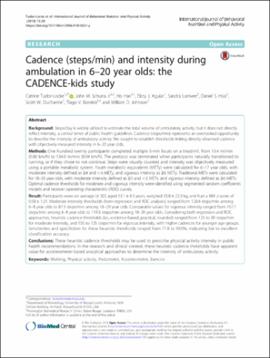| dc.contributor.author | Tudor-Locke, Catrine | |
| dc.contributor.author | Schuna, John M., Jr. | |
| dc.contributor.author | Han, Ho | |
| dc.contributor.author | Aguiar, Elroy J. | |
| dc.contributor.author | Larrivee, Sandra | |
| dc.contributor.author | Hsia, Daniel S. | |
| dc.contributor.author | Ducharme, Scott W. | |
| dc.contributor.author | Barreira, Tiago V. | |
| dc.contributor.author | Johnson, William D. | |
| dc.date.accessioned | 2022-04-19T20:20:52Z | |
| dc.date.available | 2022-04-19T20:20:52Z | |
| dc.date.issued | 2018-02-26 | |
| dc.identifier | oksd_han_cadence(stepsmin)andintensity_2018 | |
| dc.identifier.citation | Tudor-Locke, C., Schuna, J. M., Jr., Han, H., Aguiar, E. J., Larrivee, S., Hsia, D. S., ... Johnson, W. D. (2018). Cadence (steps/min) and intensity during ambulation in 6-20 year olds: The CADENCE-kids study. International Journal of Behavioral Nutrition and Physical Activity, 15, Article 20. https://doi.org/10.1186/s12966-018-0651-y | |
| dc.identifier.uri | https://hdl.handle.net/11244/335266 | |
| dc.description.abstract | Background: Steps/day is widely utilized to estimate the total volume of ambulatory activity, but it does not directly reflect intensity, a central tenet of public health guidelines. Cadence (steps/min) represents an overlooked opportunity to describe the intensity of ambulatory activity. We sought to establish thresholds linking directly observed cadence with objectively measured intensity in 6-20 year olds. | |
| dc.description.abstract | Methods: One hundred twenty participants completed multiple 5-min bouts on a treadmill, from 13.4 m/min (0.80 km/h) to 134.0 m/min (8.04 km/h). The protocol was terminated when participants naturally transitioned to running, or if they chose to not continue. Steps were visually counted and intensity was objectively measured using a portable metabolic system. Youth metabolic equivalents (METy) were calculated for 6-17 year olds, with moderate intensity defined as >/=4 and < 6 METy, and vigorous intensity as >/=6 METy. Traditional METs were calculated for 18-20 year olds, with moderate intensity defined as >/=3 and < 6 METs, and vigorous intensity defined as >/=6 METs. Optimal cadence thresholds for moderate and vigorous intensity were identified using segmented random coefficients models and receiver operating characteristic (ROC) curves. | |
| dc.description.abstract | Result: Participants were on average (+/- SD) aged 13.1 +/- 4.3 years, weighed 55.8 +/- 22.3 kg, and had a BMI z-score of 0.58 +/- 1.21. Moderate intensity thresholds (from regression and ROC analyses) ranged from 128.4 steps/min among 6-8 year olds to 87.3 steps/min among 18-20 year olds. Comparable values for vigorous intensity ranged from 157.7 steps/min among 6-8 year olds to 119.3 steps/min among 18-20 year olds. Considering both regression and ROC approaches, heuristic cadence thresholds (i.e., evidence-based, practical, rounded) ranged from 125 to 90 steps/min for moderate intensity, and 155 to 125 steps/min for vigorous intensity, with higher cadences for younger age groups. Sensitivities and specificities for these heuristic thresholds ranged from 77.8 to 99.0%, indicating fair to excellent classification accuracy. | |
| dc.description.abstract | Conclusions: These heuristic cadence thresholds may be used to prescribe physical activity intensity in public health recommendations. In the research and clinical context, these heuristic cadence thresholds have apparent value for accelerometer-based analytical approaches to determine the intensity of ambulatory activity. | |
| dc.format | application/pdf | |
| dc.language | en_US | |
| dc.publisher | Springer Science and Business Media LLC | |
| dc.relation.ispartof | International Journal of Behavioral Nutrition and Physical Activity, 15 | |
| dc.relation.uri | https://www.ncbi.nlm.nih.gov/pubmed/29482554 | |
| dc.rights | This material has been previously published. In the Oklahoma State University Library's institutional repository this version is made available through the open access principles and the terms of agreement/consent between the author(s) and the publisher. The permission policy on the use, reproduction or distribution of the material falls under fair use for educational, scholarship, and research purposes. Contact Digital Resources and Discovery Services at lib-dls@okstate.edu or 405-744-9161 for further information. | |
| dc.subject.mesh | Adolescent | |
| dc.subject.mesh | Adult | |
| dc.subject.mesh | Age Factors | |
| dc.subject.mesh | Child | |
| dc.subject.mesh | Exercise | |
| dc.subject.mesh | Exercise Test | |
| dc.subject.mesh | Female | |
| dc.subject.mesh | Humans | |
| dc.subject.mesh | Male | |
| dc.subject.mesh | Metabolic Equivalent | |
| dc.subject.mesh | Physical Exertion | |
| dc.subject.mesh | Public Health | |
| dc.subject.mesh | ROC Curve | |
| dc.subject.mesh | Running | |
| dc.subject.mesh | Walking | |
| dc.subject.mesh | Young Adult | |
| dc.title | Cadence (steps/min) and intensity during ambulation in 6-20 year olds: The CADENCE-kids study | |
| dc.date.updated | 2022-04-12T18:23:11Z | |
| osu.filename | oksd_han_cadence(stepsmin)andintensity_2018.pdf | |
| dc.description.peerreview | Peer reviewed | |
| dc.identifier.doi | 10.1186/s12966-018-0651-y | |
| dc.description.department | Community Health Sciences, Counseling and Counseling Psychology | |
| dc.type.genre | Article | |
| dc.type.material | Text | |
| dc.subject.keywords | Accelerometer | |
| dc.subject.keywords | Exercise | |
| dc.subject.keywords | Pedometer | |
| dc.subject.keywords | Physical activity | |
| dc.subject.keywords | Walking | |
| dc.subject.keywords | Clinical Research | |
| dc.subject.keywords | 11 Medical and Health Sciences | |
| dc.subject.keywords | 13 Education | |
| dc.subject.keywords | Public Health | |
| dc.rights.license | https://creativecommons.org/licenses/by/4.0/ | |
| dc.identifier.author | ScopusID: 7003557760 (Tudor-Locke, C) | |
| dc.identifier.author | ScopusID: 36802535500 (Schuna, JM) | |
| dc.identifier.author | ORCID: 0000-0003-4241-7317 (Han, H) | |
| dc.identifier.author | ScopusID: 57191291072 (Han, H) | |
| dc.identifier.author | ScopusID: 36166452400 (Aguiar, EJ) | |
| dc.identifier.author | ScopusID: 55789733100 (Larrivee, S) | |
| dc.identifier.author | ScopusID: 56646088100 (Hsia, DS) | |
| dc.identifier.author | ScopusID: 57045640200 (Ducharme, SW) | |
| dc.identifier.author | ScopusID: 26634737300 (Barreira, TV) | |
| dc.identifier.author | ScopusID: 57209265075 (Johnson, WD) | |
